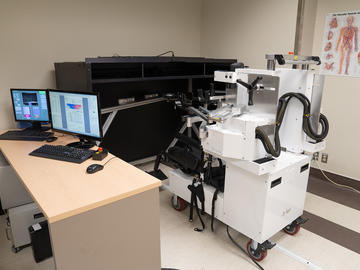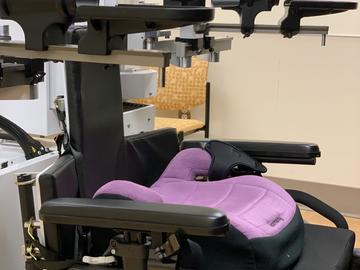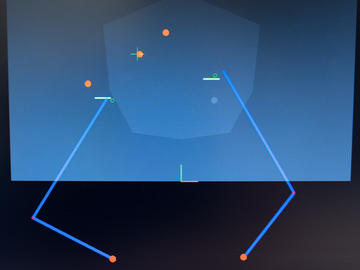Stroke Research
Our lab is committed to developing novel methods for assessing and treating individuals with neurological disorders, particularly individuals who have suffered a stroke. Using new robotic technology we are developing more accurate assessment tools to examine sensorimotor function following neurological damage. Using our robotic exoskeleton, we are helping improve stroke rehabilitation and achieve a deeper understanding of the mechanisms for stroke recovery.
Our lab is also involved in anatomically mapping and correlating brain lesion locations post-stroke to sensorimotor deficits.
Interested in participating in a research study? Let us know!
Our Current Research Studies in Adult Stroke
REhabilitation, STroke deficits And Robotic Technology
RESTART is the principle study in the Dukelow Neuro Robot Lab.
-
Study Overview
RESTART uses the Kinarm robotic exoskeleton, developed by BKIN Technologies, to assess neurological function of an individual after a stroke. Determining the nature and size of a problem in neurological function (i.e. someone's movement, sensation, and vision) after someone has had a stroke is important because this can help guide a stroke survivor's rehabilitation program. Further accurate measures of neurologic function can help to track progress with treatment and potentially predict recovery.
Assessment of neurological function has traditionally been determined through various observer-based clinical tests done by physicians and therapists. However, many of these clinical tests may not be able to detect small changes in function, or be sensitive enough to pick up on subtle deficits that have developed from the patient's stroke. Many of these clinical tests are quite long to complete, and rely heavily on the clinical experience and impression of the examiner.
The Dukelow Neuro Robot Lab takes a novel approach to assessment of neurological function after a stroke using new robotic technology. The Kinarm robotic exoskeleton is used to assesses performance in a participant's sensorimotor system through a suite of simple interactive tasks. Use of robotic assessment has significant advantages for determining neurologic function following stroke as robotic assessments are much more sensitive to subtle changes in an individual's function. Robots have the ability to measure an individual's movement and reaction time down to the millimeter and millisecond. Robotic assessments can be preformed fairly quickly when compared to many of the current clinical tests, and do not rely on the examiners own experience or impression, as the robotic analysis are performed the exact same way each time they are done. Use of robotics to assess neurological function will ultimately allow the potential for health care professionals to better determine an individual's function before they start their therapy, and then better track and assess how they are improving in their rehabilitation program.
Along with the Kinarm robotic assessment, the Dukelow Neuro Robot Lab is involved in neuroimaging in stroke. Using CT and MRI scans of stroke survivors, we are trying to anatomically map and correlate brain lesion locations to cognitive and sensorimotor deficits in stroke survivors.
-
Team Members Involved
Trainees:
- Delowar Hossain
- Matthew Chilvers
- Lydia Kuhl
Research Staff:
- Mark Piitz
- Alexandra McKinnon
Collaborators:
- Dr. Stephen Scott (Co-Investigator, Kingston ON)
Robot Enhanced Stroke Therapy Optimizes REhabilitation
-
Study Overview
RESTORE is a prospective randomized controlled trial looking at the impact of early intensive robotic rehabilitation on stroke recovery. Participants are randomized into different groups that will receive extra therapy time using the Kinarm robotic exoskeleton. Using the Kinarm, participants will go through a series of tasks to exercise the upper extremity as part of their rehabilitation program.
Using the Kinarm allows participants to do many more repetitions to exercise the arms in a shorter amount of time then would be typically possible in a standard therapy session with a therapist. The Kinarm will be able to make several hundred repetitions with the participant, and allow them to potentially push themselves harder; working as close to their own maximum ability as they can in a safe and controlled setting. The Kinarm can also measure and track any improvements that the stroke survivors make, down to the millisecond and millimeter, so that our participants can see small changes from day to day that may not be noticeable to them in daily activity.
-
Team Members Involved
Trainees:
- Emilee Cowan-Nelson
Research Staff:
- Mark Piitz
- Alexandra McKinnon
Collaborators:
- Dr. Mark Bayley (Co-Investigator, Toronto ON)
- Dr. Stephen Scott (Co-Investigator, Kingston ON)
REpetitive TMS and Multi-modality Aphasia therapy for Post-stroke aphasia
-
Study Overview
Many stroke survivors have aphasia, an impairment of language affecting the production or understanding of speech and the ability to read and write.
Non-fluent aphasia often results from stroke-related damage to Broca’s area. Recent research has focused on using brain stimulation to augment recovery of non-fluent aphasia. Several small studies have suggested 1 Hz repetitive Transcranial Magnetic Stimulation (rTMS) over the contralesional right pars triangularis (the right sided homologue of Broca’s area), when coupled with speech language therapy, can improve speech production in individuals with non-fluent aphasia poststroke. rTMS appears to inhibit inappropriate recruitment of the right pars triangularis in language production and promote reorganization of the left hemisphere when coupled with speech language therapy (SLT) leading to improvements in language function.
More intense SLT may encourage greater neuroplasticity and promote better recovery of language. Pairing rTMS with more intensive SLT treatments could potentially lead to better outcomes in stroke survivors with longstanding aphasia. One such intensive, novel SLT treatment is a technique known as Multi-Modality Aphasia Therapy (M-MAT). M-MAT improves spoken language production through shaping of responses and social-mediated repetitive practice. Participants work with a speech-language pathologist (SLP) in small groups for 2-4 hours/day for 2 weeks or more. We suspect pairing rTMS with M-MAT will result in significantly enhanced recovery of aphasia.
Further, language recovery post-stroke is traditionally thought to occur mainly in the first 2-3 months. Recent studies, however, on early SLT versus later therapy have shown mixed results. We are not aware of any rTMS trials that directly examine the impact of varying timing post stroke. Thus, we plan to compare sub-acute stroke (<3 months post-stroke) and chronic stroke (>6 months post-stroke) to better understand how timing affects response to our intervention. -
Team Members Involved
Trainees:
- Trevor Low
Research Staff:
- Mark Piitz
- Alexandra McKinnon
Robot and Brain Stimulation Enhanced Proprioceptive Rehabilitation After Stroke
-
Study Overview
Robotic therapy allows for more intense, tightly controlled rehabilitation to be performed compared to what is currently offered in clinical settings. This is due to the volume of repetitions that can be performed, something which has been shown to benefit people’s rehabilitation following stroke. Robots also allow for the explicit rehabilitation of the knowledge people have of their limbs in the absence of vision – a sense called proprioception.
Transcranial Direct Current Stimulation (tDCS) is a safe method of brain stimulation whereby two sponge electrodes are placed on the scalp. A small current (up to 2mA) is passed between the electrodes, modulating the excitability of the brain tissue through which the current passes. Early evidence shows that when paired with a training intervention, this small change in excitability is thought to enhance learning of motor and sensory skills in both healthy and stroke populations. To date, tDCS has not been investigated in relation to proprioception in a chronic stroke population, nor has it been investigated alongside a robotic rehabilitation intervention for sensory purposes.
This study will investigate a combination of two exciting therapies after stroke. One goal is to determine whether robotic treatment can improve proprioception after stroke. Another goal of the study is to examine whether applying tDCS, alongside robotic therapy, can enhance the improvements made in proprioception after stroke.
-
Team Members Involved
Trainees:
- Matthew Chilvers
Research Staff:
- Mark Piitz
- Alexandra McKinnon
Canadian Platform For Trials With Non-Invasive Brain Stimulation: Contralesional Inhibitory rTMS for Recovery of Arm Function After Stroke
-
Study Overview
Following a stroke, rehabilitation is critical for reducing stroke-related disabilities. While the current standard of care has shown some success in rehabilitating the upper limb, it can be difficult for many centre's to meet the time and intensity requirements based on staffing and funding. Transcranial magnetic stimulation (TMS) is a safe, non-invasive method of stimulating the human brain with changing magnetic fields. Repetitive TMS (rTMS) may have the potential to enhance the brain’s ability to re-learn specific functions and reduce the amount of standard therapy required to achieve certain functional gains after stroke.
Currently, there are insufficient large-scale clinical trials demonstrating the efficacy of rTMS for post-stroke functional motor recovery due to the lack of a lack of consensus regarding the optimal protocol for the clinical application of TMS in stroke populations. The Canadian Platform for Trials in Non-Invasive Brain Stimulation (CanStim) is a national platform that aims to facilitate multi-center clinical trials for non-invasive brain stimulation interventions to augment recovery from stroke. CanStim investigators convened a multidisciplinary team of experts in rTMS from institutions across Canada to form the CanStim Consensus Working Group and develop consensus recommendations for a protocol to deliver rTMS as an adjunct to standard physiotherapy in a national stroke rehabilitation clinical trial.
-
Team Members Involved
Research Staff:
- Mark Piitz
- Alexandra McKinnon
Collaborators:
- Dr. Alexander Thiel (Principal Investigator, Montreal QC)
- Dr. Jodi Edwards (Principal Investigator, Ottawa ON)
- Dr. Lara Boyd (Co-Investigator, Vancouver BC)
- Dr. Catherine Mercier (Co-Investigator, Quebec QC)
- Dr. Marc Roig (Co-Investigator, Montreal QC)
Evaluation of a Program to Increase Upper Limb Recovery After Stroke
-
Study Overview
Animal studies have found that thousands of upper limb reach to grasp repetitions may be necessary for driving functional recovery following a stroke; however, current doses of upper limb movement practice during rehabilitation are far below that of animal studies. This is understandable as therapists have to address multiple body functions affected by the stroke during their therapy sessions. One potential method for increasing movement practice is to facilitate greater incorporation of the upper limb into daily activities. Unfortunately, this potential solution is not straightforward due to the increased reliance on the less affected upper limb following a stroke. Information from wearable sensors may help counteract this over-reliance by facilitating increased awareness of what the affected upper limb is doing, and by providing external cues to use the affected upper limb. Current wearable devices that rely on accelerometer technology do not provide information that is easy to interpret; however, a new wrist-worn device (the TENZR) has been developed that is able to provide repetitions of reach to grasp movements (called hand counts). Preliminary studies have shown that the technology used in this wearable device has suitable reliability and validity in people with stroke. Cuing from wearable sensors alone may not be enough to facilitate greater practice as use of the affected limb can be very frustrating when there is reduced functional capacity. The next step is to determine whether wearing this device in conjunction with a program aiming to increase functional capacity (i.e. exercise) is feasible and can increase the amount of movement practice for the duration of the time the device is worn.
The purpose of this study is to determine the feasibility of a treatment program that involves feedback from the TENZR wearable device in combination with an exercise program, and to determine the effect that the treatment program has on the amount of stroke-affected upper limb use. -
Team Members Involved
Research Staff:
- Mark Piitz
- Alexandra McKinnon
Collaborators:
- Dr. Janice Eng (Principal Investigator, Vancouver BC)
- Dr. Ruth Barclay (Co-Investigator, Winnipeg MB)
- Dr. Mark Bayley (Co-Investigator, Toronto ON)
- Dr. Sandra Black (Co-Investigator, Toronto ON)
- Dr. Bradley MacIntosh (Co-Investigator, Toronto ON)
- Dr. Marilyn Mackay-Lyons (Co-Investigator, Halifax NS)
- Dr. Sepideh Pooyania (Co-Investigator, Winnipeg MB)
- Dr. Michelle Ploughman (Co-Investigator, St. John's NFLD)
- Dr. Robert Teasell (Co-Investigator, London ON)
Independent Use of a Brain Measurement-Based Rehabilitation System by Stroke Survivors: A Randomized Open Label Phase 1 Clinical Trial with Blinded Evaluation
-
Study Overview
Stroke is the most common cause of adult disability; more specifically, movement impairments are the most common form of disability caused by stroke. Post-stroke physical rehabilitation is widely regarded as the necessary treatment to allow a stroke survivor to return home after a moderate or moderately severe stroke, and prescription of outpatient rehabilitation for stroke survivors who present with functional movement deficits upon discharge is the current standard of care. Moreover, studies have shown rehabilitation can continue to improve the functional movement abilities of stroke survivors throughout the chronic phases of stroke recovery, even years after the stroke.
Rehabilitation leads to changes in cortical connectivity in the brain, so-called neuroplasticity. These changes include increasing the number of connections between neurons through synaptogenesis, dendritic branching, altered neurotransmitter levels, and remapping of regions within the brain. While neuroplastic changes occur post-stroke independent of rehabilitation, studies show that rehabilitation drives beneficial post-stroke neuroplasticity within the sensorimotor system, positively contributing to enhanced improvements in functional status. However, studies in animal models have demonstrated that a large volume of repetitions are required to drive this beneficial neuroplasticity.
The Axem Home prototype is a rehabilitation system designed to be used independently by a stroke survivor to facilitate physical rehabilitation exercises in their home environment. This system involves displaying the users' (non-diagnostic) brain activity during upper-extremity rehabilitation exercises as well as their adherence to rehabilitation goals. There is preliminary evidence that the provision of brain activity feedback from the motor cortex to patients during rehabilitation could provide an additional enhancement to the effectiveness of their rehabilitation exercises. The purpose of this study is to determine the safety and feasibility of using the Axem Home prototype to facilitate independent, at-home post-stroke physical rehabilitation. -
Team Members Involved
Research Staff:
- Mark Piitz
- Alexandra McKinnon
Collaborators:
Our Current Research Studies in Perinatal Stroke & Cerebral Palsy
Effect of Robotic Therapy and tCDS on Motor Function in Children with Cerebral Palsy
-
Study Overview
Throughout the lifespan, the most focused period of risk for ischemic stroke is the week you are born. Perinatal ischemic stroke occurs in >1:2,000 live births and is a leading cause of lifelong disability in children, with the impact extending to the family and lasting decades. Perinatal stroke is responsible for the vast majority of the >10,000 Canadian children affected by hemiplegic cerebral palsy (HCP). Children may also have bilateral CP where they have deficits on both sides of their body.
At present, rehabilitation is one of the few treatments for CP. Traditionally this has involved hand over hand training with a therapist to regain function, but more recently technologies such as robotics and non-invasive brain stimulation with transcranial direct current stimulation (tDCS) have surfaced as promising experimental treatments. Robotics allow children to interact with virtual reality environments and play games to force increased use of the arm while tDCS safely modulates neuronal activity in specific areas of the brain. Our team has more experience using robotics and non-invasive stimulation in pediatric HCP than any other center in the world. Our previous work has successfully used robots to define new understandings of sensory and motor dysfunction in HCP. We have also conducted positive clinical trials showing that brain stimulation can enhance motor learning in typically developing children and enhance therapy in those with HCP. -
Team Members Involved
Research Staff:
- Mark Piitz
- Alexandra McKinnon
Collaborators:
- Dr. Adam Kirton (Co-Investigator, Calgary AB)
-
Study Overview
Cerebral Palsy is the general term given to a group of neurological disorders that develop close to, or at the time of birth, or appear very early in infancy. Pediatric stroke is one cause of Cerebral Palsy. Similar to the adult stroke study RESTART, we are interested in determining how neurologic function has been affected in children with cerebral palsy.
Currently standardized clinical rehabilitation assessments for children with cerebral palsy focus heavily on measuring motor function. We are interested in better understanding problems with sensory function that occur after pediatric stroke. The Kinarm robotic exoskeleton is currently being used to help better assess sensorimotor function in children with cerebral palsy in collaboration with Dr. Adam Kirton's lab. Our robotic exoskeleton is advantageous in determining how sensorimotor function is affected in children with cerebral palsy, as assessments are more accurate, and can be done in a non-invasive manner. It is important to accurately assess how motor and sensory function has been affected in children with cerebral palsy, because being able to fully understand how neurological function has been affected and may be useful in planning future treatment.
-
Team Members Involved
Research Staff:
- Mark Piitz
- Alexandra McKinnon
Collaborators:
- Dr. Adam Kirton (Co-Investigator, Calgary AB)




